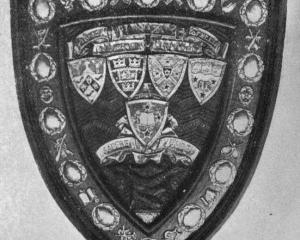
Up to the present the embankment has stood the terrific strain put upon it, but fears are entertained unless there is an abatement of the flood waters the structure will give way. Many residents consider that the water at the traffic bridge has reached as high a level as in 1878, and the lowest estimate is that it is 2ft lower. The maximum height was reached about noon when the water was close on 17ft at the bridge, judging by the flood gate cylinder marks, which run to 12ft. It steadied then for a few hours, when it commenced to recede coincident with a break in embankment at the Hermitage, near Stirling. This break is thought to be responsible for the fall in the river at Balclutha, as the pressure has considerably eased. On Monday evening a gang of men was put on to patrol the bank on the town side of the river. At 5 a.m yesterday the fire-bell was rung to summon assistance, as the water was found to be percolating through the bank in various places. Help was readily forthcoming, but half an hour later the bell was again rung, as further leaks were discovered, and more labour was required to fight the threatened danger. Another peremptory summons for additional assistance was given at 8 a.m, and shortly afterwards close on 100 men were working at high pressure with sandbags to stop the breaches. The river rose at the rate of 2in per hour till 1 p.m, and then much faster till 4 p.m, when it apparently became stationary.
Shortly after 1 a.m yesterday the river overflowed the bank at Mr Crawford Anderson's and rushed in a torrent into Stirling. In 10 minutes the flood water surged ruthlessly through the town to a depth of three feet, and several residents had considerable difficulty in escaping to safety. With the exception of two families, all residents of the low-lying portion beat a hasty retreat to friends' houses in a position of safety.
Shortly after 4 p.m the embankment broke at the Hermitage (midway between Stirling and Balclutha), and the flood which at Stirling had shown a fall of about an inch between 3 and 4 o'clock, rushed into the stricken town with renewed force. Soon the water mark had risen by a foot and was still rising at 7 p.m
Manuherikia bridge
Alexandra: The recent visit of Sir William Fraser, Minister of Public Works, to this district was productive of some practical good. The local agitation for a bridge over the Manuherikia River received endorsement from the Minister. A visit to the proposed site convinced the Minister that the bridge was an urgent necessity, and he authorised the preparation of the plans and the calling of tenders. The proposed bridge, which will cost about 2000, will, when erected, give the Galloway residents direct and safe road communication with Alexandra and neighbourhood. As a portion of the land at Galloway has been reserved for returned soldiers, this bridge had to come sooner or later. Meantime, the ford is dangerous at all times, and quite impassable during a flood.
Trapping, suspended for the summer months, is likely to start again about the middle of February. The local rabbit preserve factory is adding cool chambers so as to cope with a rush of rabbits in a larger number than the staff can handle in one day. This industry is proving a real boon to the district, giving employment to a large number of residents, trappers, carters, skinners, and large staffs at the factories. - ODT 29.1.1919.












